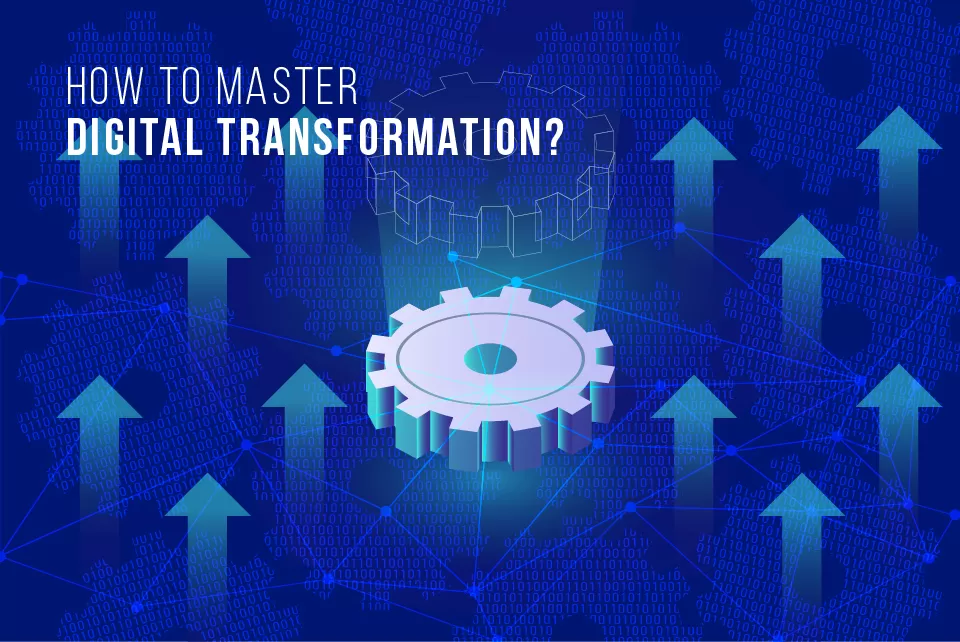Mastering Enterprise Digital Transformation: Building Blocks of a Successful Strategy

- Building Blocks of Successful Enterprise Digital Transformation
- Core Mission
- Willingness to Bring Change
- Transparency in the Organization
- Broader Leadership Vision
- Partner and Collaborate
- Breaking Down Silos
- Onboarding Data Experts
- New Ways to Innovate
- Studying your Audiences
- Reusing Existing Tools
- Cloud Adoption
- Modular Approach
- Track and Analyse Performance
- Wrapping Up
Share this blog
The Millennials and Generation Z of this hyper-connected economy value transparency and honesty more than anything. They look for real-time information at the click of a button and crave to have a direct relationship with brands.
To cope with this, businesses must focus on enhancing customer experiences by engaging with them in new ways. While some businesses handle this smoothly, many face pressures to keep up with the changing trends and deliver more value to their customers.
When it comes to adopting digital transformation, most enterprises and their CxOs do not know where to start or what to do. This blog is a guide for all such CxOs and decision-makers to implement digital transformation solutions to their business.
Building Blocks of Successful Enterprise Digital Transformation
Core Mission
Digital transformation is about defining and implementing new goals and visions to transform the organization as a whole. List out the challenges you face and define your core mission.
Willingness to Bring Change
Digital transformation is a serious change management process and the people in the organization must be ready to face the change and take measures to successfully render it. It will affect all areas of your business and you must be ready to withstand the challenges and pain that follows.
Transparency in the Organization
Understand that this transformation cannot happen overnight and it will require participation from all the departments. Hence, everyone in the organization needs to be aware of and involved in the transformation plan.
Broader Leadership Vision
Consider all the possible technologies and tools and the opportunities and impacts they bring to various aspects of your business. Be open to experimenting with different business models and tools to figure out what works best for your organization.
Partner and Collaborate
Hire and partner with experts who provide digital transformation services and products to help you guide through your journey. Collaborate with companies who already use innovative technologies and tools and appoint them to align your efforts to your goals.
Breaking Down Silos
Break down silos in your organization by building cross-organizational teams and aligning all the departments to a single shared vision. This will empower your employees and improve workforce engagement.
Onboarding Data Experts
Data is the new oil in this digital era and it needs to be leveraged to its maximum. Hire new resources if you need, and get data scientists and experts onboard to utilize the data in the most fruitful manner.
New Ways to Innovate
Experiment with various technologies and ways to disrupt how you function currently. Research on what works and what doesn’t by implementing new innovative technologies and tools into your business functions.
Studying your Audiences
Your digital transformation strategy needs to be customer-centric. Analyse the behaviour, interests and expectations of your customers and transform your business in a way that it enhances their experience.
Reusing Existing Tools
Before investing in new business models and tools, go through your existing tools and figure out ways to utilize them. Enhance your existing systems by incorporating new ways of carrying out certain tasks and aligning them to your vision.
Cloud Adoption
Make it easy for your employees to access data and work from anywhere and anytime by adopting cloud. This will improve productivity, scalability and efficiency of the teams while keeping the data secure.
Modular Approach
There is no one-size-fits-all strategy for digital transformation. You need to craft a suitable plan by considering your business goals and requirements. If you need help, get the support of a digital transformation services provider.
Track and Analyse Performance
Once you have implemented certain changes in your organization, monitor the impacts of your efforts. The insights will help you make the necessary amends in your plan to achieve the desired results.
Wrapping Up
Digital transformation, when implemented in the right manner, can bring agility, speed and adaptability to your enterprise, which can never be replicated. Need help with starting your digital journey? Gateway Digital is an expert technology partner offering digital transformation solutions to businesses across industries. To know more about their offerings and expertise, visit www.thegatewaydigital.com or write to hello@thegatewaydigital.com.
Get in Touch
Related Blogs

The 5 FinTech Product Engineering Trends Quietly Reshaping Global Finance

Bridging the Gap Between Innovation and Measurable Performance in the Banking Industry

Cloud at the Heart of Digital Manufacturing

Agile Methodologies in Retail Product Development: Flexibility and Responsiveness to Market Changes

The Nordic AI Advantage: Operations That Actually Work

Social Commerce, Mobile Commerce & Smart Commerce: The New Triad of Digital Growth

Staying Ahead in the AI Search Era: How GEO Complements Traditional SEO

CIOs, It’s Time to Lead AI in Healthcare—Not Just Watch It

Balancing Feature Development with Platform Enhancement: A Strategic Imperative

Managing IT Costs Effectively: A Strategic Approach to Balancing Growth and Efficiency

The Hidden Complexity of Scaling Cloud Operations: What Most Strategies Miss

Managing Technical Debt: Balancing Innovation with Sustainability

Maintaining Development Velocity While Ensuring Quality: The Balancing Act

Navigating Financial Strategies for Global Expansion in SaaS

Precision in Complexity: Redefining Capital Allocation for Sustainable Growth

Beyond Silos: Rethinking Cross-Functional Collaboration for Scalable Product Development

Simplifying Global Expansion: The Power of One Strategic Partner

The Unfinished Symphony of Digital Transformation: From Strategy to Execution

Beyond Traditional Process Intelligence: Integrating Emerging Technologies for a Competitive Edge

Tekninen Velka – Kuinka Se Haittaa Kasvua ja Miten Sen Saa Hallintaan?

A Deep Dive into Product Engineering: Process, Roles, and Best Practices

What is Cyber Resilience? An In-Depth Guide

A Comprehensive Guide to Cloud Transformation

24 Emerging Software Development Trends Transforming 2024

Is AI Secure? Addressing Cybersecurity Risks with AI

How Is Cloud Computing Transforming Sustainable Healthcare in the Nordics?

Gateway Digital is Neste Napcon’s Partner in Creating Digital Learning Environments for the Process Industry

Tuotekehitysyhteistyön avulla joustavuutta ja kustannushyötyjä – Case School Day

Petteri paju vahvistamaan Gatewayn myyntiä

Top 6 Trends Transforming Logistics and Supply Chain in 2020

Why is it Important to Hire the Right Employees to Grow your Business?

Miten IT-alan ammattilaisten vaje näkyy Suomessa?

How Can Emerging Technology Facilitate Faster Start-up Growth?

The Need For Smart Logistic Planning: Takeaways From The Suez Canal Crisis

Gateway Digital AS and Retailtech strengthen their strategic partnership

Gateway Digital and Digitate enters strategic partnership

The DACH cloud computing industry in 2021 and beyond

Why Germany is home to the most innovative Tech Startups

Dataplattform för att identifiera bilreservdelar vinner pris inom hållbarhet

AWS vs GCP vs Microsoft Azure: Everything you need to know

Ensuring a higher ROI on your Technology Investment: Here’s How

Why the future of Startups & Scaleups depends on Technology Partner

Infographic: Elevate your Business with Augmented Supply Chain

Infographic: Empowering the Digital Healthcare Ecosystem

Infographic: Why Strategic Technology Partnerships are imperative for ISVs

Infographic: How PES is Empowering the Digital Healthcare landscape

Impact of Covid 19 on the Automotive Industry

How COVID-19 is Changing the Face of Digital Healthcare

Transform your Digital Journey with Strategic Technology Partnerships

Succeed your Business with Partnerships – The New Normal for Fintech!

Supply Chain Focus Areas to Mitigate COVID-19 Disruptions

How Digital Transformation is Redefining the Healthcare Industry

Benefits of Digitising Your Product Development Process

How to Develop a New Product (From Concept to Market)

How Automotive and Technology Experts See the Future of Connected Vehicles through Future Tech 5G Service

Industry Digitization will be Top Opportunity for 5G business solutions

5G Products & Solutions in 2023 & Beyond– What Should we expect from 5g network software?

Everything You Need to Know About 5G network as a service

Cloud Companies Chase Future in Cybersecurity ‘Wild West’

The Future of Lawyers: Legal Tech, AI, Big Data And Online Courts

Why Covid-19 Could Expedite the Role of RegTech in Finance

3 Elements For Success With Mobility As A Service In Our Cities

Digitalization is Upending Global Logistics

Mastering the Duality of Digital: How Companies Withstand Disruption

iGaming Technology Trends to Watch

73% Growth and Instant Blockbusters: How Online Gaming Industry Is Blowing Up During the Pandemic

The 5 Biggest Cybersecurity Trends In 2020 Everyone Should Know About

Why Cybersecurity Is Really A Business Problem

Technological Disruption or Next Industrial Revolution?

What Will Be The Future Success Of Fashion Retail In The Digital Age

The Banking Industry Is Spending Wildly on the Latest Tech

Disruption in Manufacturing: Managing Unexpected Risks

5 Manufacturing Tech Trends Poised To Disrupt Your Business

Digital Disruption in the Manufacturing Industry

Future Factory: How Technology Is Transforming Manufacturing

Five Ways the Internet of Things is Transforming Businesses Today

The Mobility-as-a-Service Market will Register a CAGR of Over 35% by 2023

3 Ways Every Company Should Prepare For The Internet Of Things

The Three Stages Of Cloud Transformation: Application, Network, Security

Cloud Computing Seen as Tech Haven Amid Pandemic Uncertainty

How Multi-Cloud and Digital Transformation Fit Together

8 Ways Cloud Is Transforming Business

Mixed Reality Finds Its Niche in Industrial and Business Applications

Virtual Reality is Making Marketing and Training More Effective for Businesses

What Leaders Need To Know About Augmented Reality

The 5 Biggest Virtual And Augmented Reality Trends In 2020 Everyone Should Know About

DevOps Model: The Role of Quality Assurance Redefined

Quality Engineering Has DevOps and Agile in the Driving Seat

How QA Can Support Businesses in the Journey of Digital Transformation

Quality Assurance Is Critical In Software Development And Increasingly Automated

Resolving Challenges of Auto ISVs with Fruitful Technology Partnerships

Resolve Fleet Management Challenges with Innovative Digital Automotive Solutions

Top 3 Factors Impacting Customer Satisfaction of Modern Car Buyers

Fleet Telematics Solution: Driving Great Business for Automotive Ecosystems

Top Supply Chain Tech Trends

How Artificial Intelligence Benefits Logistics and Supply Chain Management

Fleet Management in 2024 & Beyond: What Does the Future Look Like?

How to Identify a Trusted online iGaming Solutions Provider?

Center of Excellence: Building Intelligent Solutions for the Enterprises of Tomorrow

Want to Succeed in Digital Transformation? Choose the Right Technology Partner
INDUSTRIES
PLATFORMS
SERVICES
CONSULTING
- AlvariumTM - Design Led ConsultingOpens a new window
- Digital Marketing Services
- Automotive Aftermarket
- Digital Logistics
- Remote Engineering
PROFESSIONAL SERVICES
DIGITAL
FUTURE ENGINEERING
Let's Talk
Book a Meeting
We value your privacy.
This website uses cookies and similar technologies to improve your browsing experience, measure our audience, collect useful information, and provide you with relevant content. By selecting “Accept & Continue”, you confirm that you provide your consent for the use of your information, and have read and agree to our Privacy Policy , and Terms of Use.DeclineAccept & ContinueCookie settings
Privacy Overview
| Cookie | Duration | Description |
|---|---|---|
| cookielawinfo-checkbox-analytics | 11 months | This cookie is set by GDPR Cookie Consent plugin. The cookie is used to store the user consent for the cookies in the category "Analytics". |
| cookielawinfo-checkbox-functional | 11 months | The cookie is set by GDPR cookie consent to record the user consent for the cookies in the category "Functional". |
| cookielawinfo-checkbox-necessary | 11 months | This cookie is set by GDPR Cookie Consent plugin. The cookies is used to store the user consent for the cookies in the category "Necessary". |
| cookielawinfo-checkbox-others | 11 months | This cookie is set by GDPR Cookie Consent plugin. The cookie is used to store the user consent for the cookies in the category "Other. |
| cookielawinfo-checkbox-performance | 11 months | This cookie is set by GDPR Cookie Consent plugin. The cookie is used to store the user consent for the cookies in the category "Performance". |
| viewed_cookie_policy | 11 months | The cookie is set by the GDPR Cookie Consent plugin and is used to store whether or not user has consented to the use of cookies. It does not store any personal data. |

